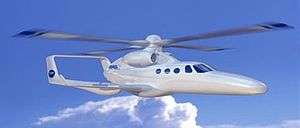GBA-DARPA Heliplane
The GBA-DARPA Heliplane was a proof-of-concept, long-range, VTOL aircraft intended to cruise at twice the speed of conventional helicopters.[1] It was funded by the Defense Advanced Research Projects Agency (DARPA) and designed by Groen Brothers Aviation (GBA), which has since been re-branded as Skyworks Global.
| Heliplane | |
|---|---|
 | |
| Image of baseline GBA-DARPA Heliplane concept, showing its free-spinning rotor, which is fitted with integral tipjets, fed with bypass air from two Williams gas-turbine propulsion engines | |
| Role | Experimental helicopter |
| National origin | United States |
| Manufacturer | GBA-DARPA |
| Status | Cancelled |
Development
DARPA's objective was to achieve performance with a rotary-wing aircraft comparable to that of a fixed-wing plane. The concept combined technical aspects of a gyroplane, which GBA had been working on since the late 1980s,[2] with a fixed-wing business jet.
The work was part of a potential multi-year, US$40-million, four-phase program. GBA, along with Georgia Tech, Adams Aircraft Industries, and Williams International, worked on Phase 1 of that program, a 15-month effort funded at $6.4 million. Phase 1B of the program was managed by Georgia Tech, using GBA as a subcontractor. Phase 2 development was to include a "subscale wind tunnel demonstration in the high-speed, high-altitude wind tunnel at NASA Langley and the building of a full-scale tipjet nozzle. Phase 2 [was] anticipated to be a substantially bigger undertaking (valued at $24-28 million)."[1]
Due to issues with noise generated by the tipjets, the program was terminated by DARPA in 2008.[3]
In 2012, Groen Brothers Aviation was rescued by investor Steve Stevanovich as it was collapsing and nearly bankrupt, and was renamed as Skyworks Global in 2017. In July 2019, Skyworks partnered with Northrop Grumman-owned Scaled Composites to design, build and test its first VertiJet gyrocopter prototype, aiming for a 348kn (644km/h) cruise and a 1,000nmi (1,850km) range, to fly in 18-24 months. It could fulfil the US Marine Corps’ armed escort requirements disclosed in April 2019, a rotorcraft that can keep up with its Bell Boeing V-22 Osprey, as an add-on to the US Army’s FLRAA programme. A commercial gyrocopter carrying four passengers could be built for less than $10 million.[4]
See Also
References
- Pengeley, R. (June 2009). "Gyrodyne Testing Resumes in the US". Jane's International Defence Review. p. 13.
- "Best Inventions of 2001: Gyroplane". Time. 19 November 2001.
- "Darpa Takes Another Shot At High-Speed VTOL". Aerospace Daily & Defense Report. Aviation Week. 26 February 2013. Retrieved 31 July 2018.
- Garrett Reim (16 July 2019). "Skyworks gyrocopter returns from the brink". Flightglobal.